Hands-on with Control, Remedy's most ambitious game yet
The Alan Wake developer's latest is strange, compelling and visually inventive.
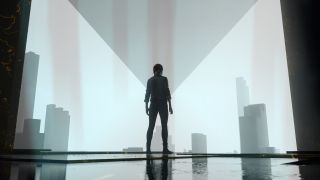
As I levitate with almost complete freedom around the Brutalist atrium of the Central Research area—all clean concrete walkways broken up by formidable trees—I have a sense that this is finally the game that Remedy always wanted to make; the developer’s creative Promised Land.
Conversations around Remedy games usually revolve as much around their constraints and shortcomings as their weird brilliance and ambition, but Control feels like it doesn't have those same limitations.
A big part of that is the hub-based and more systemic structure of the game. Control has something of the immersive sim, encouraging you to explore rooms and areas you might otherwise miss to pick up new powers. You can watch eerily over-saturated videos of scientists talking about dimensional fissures, and shuffle through documents that fill you in on the disaster that befell the place you’re exploring.
This place is the Oldest House, the headquarters of the FBC—a government division that investigates paranormal activity. You are new boss Jesse Faden, and it’s your first day on the job. The thing is, instead of being shown to your gold-plaqued desk and arranging a ‘Getting-to-know-you’ conference call, you arrive to find people floating eerily in the building’s vertiginous expanses—presumably dead—and black glitchy vortexes of violent energy swirling and crunching towards you.
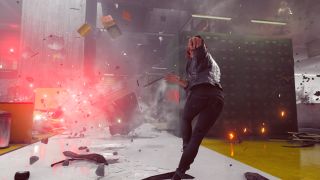
It’s a unique vision of the ‘Science Gone Wrong’ trope so beloved by games. In a way, the tone is post-Lovecraftian, set in today’s age where beliefs in Gods and squid-faced deities have made way for the cold power of physics, and a sense that whatever’s beyond the tenuous veil of this dimension is much less tangible and anthropomorphic.
But where the laws of cosmic physics are normally terrifying through their stark apathy to humanity, in Control they’re something more malevolent, as I discover in my hands-on. The corrupting force throughout the facility, known as ‘The Hiss’, manifests in all kinds of strange forms. It possesses people, for example, and sets them out to kill you. I encountered regular gunning grunts on the ground, but also more powerful levitating enemies, telekinetically hauling chairs, tables, chunks of concrete, you-name-it, at me.
In a ghoulish callback to Alan Wake, these people ramble insane scientific nothings to themselves (at least, nothing that my non-sciency brain can translate). You get the sense that their minds have been stripped of the human component and left only with formulae and theories attempting to make sense of whatever dark energy has taken over the building.
The biggest gaming news, reviews and hardware deals
Keep up to date with the most important stories and the best deals, as picked by the PC Gamer team.
The good news is that you, Jesse, have powers of your own. You can levitate high into the air to meet your flying foes, then engage in a duel of flinging whatever the hell your telekinetic pull ability can reel in towards you. Within moments, the courtyard of Central Research is strewn with debris as we entwine ourselves in a gravity-free tussle of office objects.
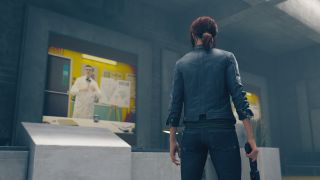
But there’s more to Jesse than levitation. By aiming at the enemy and clicking the right analog stick, we dash through the air, slamming into him and disintegrating him into a shower of sparks.
That airdash contributes to the liberating weightlessness of controlling Jesse. You can only levitate for a limited amount of time, and can’t keep going up forever, but you can airdash in any direction level with or below you, which means you can, for example, dash over to a ledge and haul yourself up, or dash into the ground to convert it into a devastating ground pound.
Another trick I played with was seizing control of wounded enemies and getting them to fight for me for a limited time. I did this to the grunts, the hovering types, and the big balls of healing energy too, which would otherwise be buffing the enemy. It makes each battle a game of control, as you wrestle over physical objects to lob around and enemies to possess.
I was overpowered in the hands-on, which Remedy's Thomas Puha assures me won’t be the case in the final game; you will need to unlock abilities and increase your health to get to that point. Your health doesn’t regenerate automatically either, so you need to scour the building for pickups or find creative ways (like possessing the healing orbs) to patch yourself up.
From the hub-based world to the light puzzle elements that unlock new pathways, Control nods to what I think of as ‘designer genres’ like the Metroidvania, Soulslike and immersive sim. It’s abandoning the blinkered linearity of Remedy’s past efforts, and going into territory that feels like Alan Wake would’ve gone to had these ideas been more prevalent at the time.
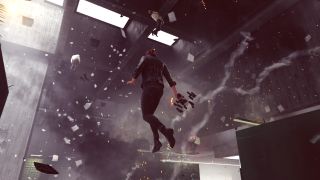
Beyond the combat, I don’t get to do all that much interacting with the world. It’s more a case of exploring strange rooms, each with their own surrealistic reality-warping twists. There’s a music recording studio (with no discernible purpose for now), and a ‘Hall of Mirrors, a lavishly decorated area that's all crimsons and golds with an eye-teasing pattern on the walls. Suddenly, the walls in here shift and new corridors open up, which you diligently follow, taking each new turn as it manifests in front of you until you loop back to the original room, where a new pathway opens, leading to a new power for you to use.
Another fork leads me down to an area that’s overrun by a golden glowing mold and filled with enemies who seem to be almost falling to pieces—pathetic and hollowed by whatever the exact corruption is in this particular area. In this area, and several others, there are square indents on walls that require you to grab a cube (telekinetically, of course) and insert it to unlock a door or get a nearby elevator working.
Puha takes control for a mini-boss fight against an Astral Spike—that swirling mass of glitchy energy I talked about earlier. It fits into the ‘shapeless black mass’ category alongside unloved video-game enemies like Prey’s Typhon or the Pus of Man in Dark Souls 3, but given that I’m extremely fond of both of those games, it works for me. Instead of fighting it head-on however, Puha lures it through a large containment door, then loops back around to the main room and shuts it inside.
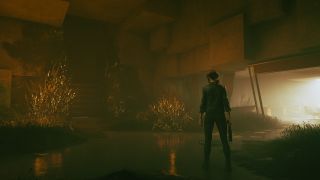
These are pretty simple puzzle-based interactions, and I’d like to see them go a little deeper in the final game, but given that the demo aimed to mainly showcase the combat, I’m holding out hope that we’ll see this area expanded on a bit more. That said, it’s clear that Remedy is staying true to its specialties and veering more towards the cinematic than the fiddly and intricate.
The Oldest House fluctuates between a particularly tasteful form of ‘cold and corporate’ and impressively other. One moment I’m in a bright atrium, designed to intimidate and impress visitors, the next I’m tentatively creeping down a dark stone corridor, with angles and surfaces jutting out of places where there’s really no need for angles and surfaces to exist. In 20 minutes I saw more visual variety than in entire other games.
Then, the already interworldly reality of the Oldest House dissipates, and a misty grey landscape of obelisks and strange stepped pyramids unravels before me. This is the Astral Plane. Somewhere in here, Puha tells me, is an inverted black pyramid that I suspect has an awful lot to do with the mysterious events back in what approximates in this game to ‘the real world’.
Remedy, the masters of reality-bending intrigue are weaving their most intricate web yet
Even though the game is just five months away, I felt like Control remains a mystery, and I like that. There’s the story, of course, which seems even more intriguing and cryptic now than before I played the preview build, and there’s a crafting and upgrade system that I barely had the chance to touch.
There are still points that need ironing out. The combat, for all its wonderful low-gravity flow, still feels rather ethereal, with the enemies looking and feeling twiggy and unimpactful when you’re duffing them up. I’m also not sure how much longevity there is in throwing bits of furniture and detritus around at enemies, so it’ll be up to the upgradeable Service Weapon—your shape-shifting firearm—and whatever powers we haven’t seen yet to ensure the action remains nice and varied throughout.
But these are all fixable. Remedy have the right ideas here, and I came away with fresh questions about what the hell is going on in this most abstract of downtown skyscrapers.
Remedy, the masters of reality-bending intrigue are weaving their most intricate web yet, and I’m more than happy to get caught up in it.
Robert is a freelance writer and chronic game tinkerer who spends many hours modding games then not playing them, and hiding behind doors with a shotgun in Hunt: Showdown. Wishes to spend his dying moments on Earth scrolling through his games library on a TV-friendly frontend that unifies all PC game launchers.
Most Popular


